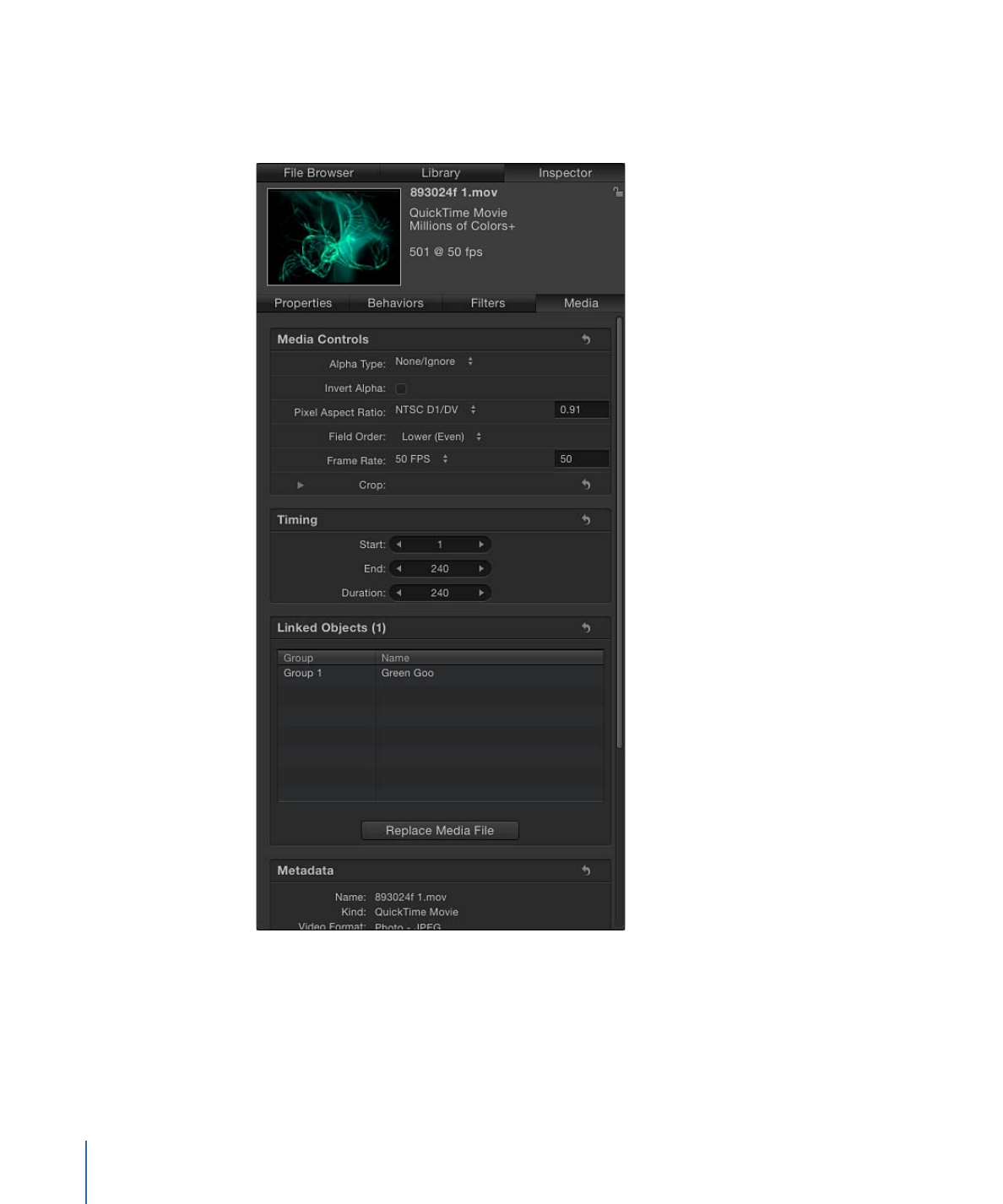
Media Inspector
The following controls let you modify source media in the Media list. Modifying source
media modifies all layers in a project linked to that source media.
Note: The parameters described below do not apply to Photoshop files imported as
separate layers. PDF files with transparent backgrounds do not have the Alpha Type or
Invert Alpha parameters.
214
Chapter 6
Creating and Managing Projects

Alpha Type:
Use this pop-up menu to choose how Motion deals with alpha channels in
the media item. An alpha channel contains information defining areas of transparency
in the image or movie. When you import an image file or QuickTime movie, its alpha
channel is immediately recognized by Motion. There several different ways to embed
alpha channel information into files, which correspond to the options in this menu. Motion
assigns an option based on an analysis of the object when it is imported, but you can
override the default if necessary, by choosing any of the following:
• None/Ignore: This is the default setting for objects with no alpha channel. This option
also allows you to ignore an object’s alpha channel, so the entire object appears solid.
• Straight: These alpha channels are kept separate from the red, green, and blue channels
of an image. Media files using straight alpha channels appear fine when used in a
composition, but they may look odd when viewed in another application. Translucent
effects such as volumetric lighting or lens flares in a computer-generated image can
appear distorted until the clip is used in a composition. If Straight is chosen but you
see a black, white, or colored fringe around the object, this parameter is incorrectly set
and should be changed to a Premultiplied option, depending on the color of the fringe.
• Premultiplied-Black: This type of alpha channel is multiplied with the clip’s red, green,
and blue channels. As a result, objects with premultiplied alpha channels look correct,
even with translucent lighting effects, because the entire image is precomposited
against a solid color. This option interprets alpha channels that are precomposited
against black.
• Premultiplied-White: This option interprets alpha channels that are precomposited
against white.
• Guess Alpha Type: This option forces Motion to analyze the file in an attempt to figure
out what kind of alpha channel is used. If you’re unsure, use this setting.
Invert Alpha:
Select this checkbox to invert an alpha channel that is incorrectly generated
in reverse. Ordinarily, an alpha channel is a grayscale channel, where white represents
areas of 100 percent opacity (solid), gray regions represent translucent areas, and black
represents 0 percent opacity (transparent).
Pixel Aspect Ratio:
Use this pop-up menu to set the type of pixel relevant to the project,
square or nonsquare. In general, objects created for computer display, film, and
high-definition video use square pixels, while objects created for some video formats
(such as DV, HDV, DVCPRO HD, and others) use nonsquare pixels. A value field to the right
of this pop-up menu displays the numeric aspect ratio, in case you need a custom ratio.
By correctly identifying each object you add to your project, you can mix and match both
kinds of media.
215
Chapter 6
Creating and Managing Projects

Field Order:
Use this pop-up menu to choose a field order that matches the field order
of the device used to capture an interlaced clip. There are two choices: Upper (Odd) or
Lower (Even). If you choose incorrectly, you’ll notice during playback that the video stutters
during playback. When this happens, choose the opposite field order. Clips shot on film
or with a progressive scan video camera have no interlacing, therefore Field Order should
be set to None. By correctly identifying each object in your project, you can mix and
match clips with a different field order. For more information about field order and
interlacing, see
Field Order
.
Frame Rate:
Use this pop-up menu to choose a frame rate in frames per second (fps)
that matches a clip’s native rate. For example, film is 24 fps, PAL video is 25 fps, and NTSC
video is 29.97 fps. Additional frame rates are available for other video formats. If the frame
rate you require is not listed, enter a number in the text field to the right of the pop-up
menu. If you modify a QuickTime file’s frame rate but need to change it back to the file’s
original rate, choose “From file” at the bottom of the Frame Rate pop-up menu.
Although you can mix clips using different frame rates, clips playing at a frame rate
different from that of the project might not play smoothly.
Note: Project frame rates are determined by the project preset. To edit a preset or to
create a preset, choose Motion > Preferences and use the options in the Presets pane.
Fixed Width and Fixed Height:
Use these sliders (available for still images) to change
the resolution of source media. When the Large Stills control (in Motion Preferences) is
set to Scale to Canvas Size, these values display the resolution of the original file.
When a PDF is selected in the Media list, these controls set the maximum resolution to
which a PDF object can be smoothly scaled. For more information, see
Fixing the
Resolution of a PDF Object
.
Crop:
Click the disclosure triangle to reveal four sliders that define the number of pixels
to be cropped from each of the source media’s four sides, relative to the outer edge of
the bounding box that surrounds that source media. Cropping an item in the Media list
also crops all instances of that item in layers of the project. A similar Crop parameter
appears in the Properties Inspector when you select a layer in the Layers list. For more
information, see
Parameters in the Properties Inspector
.
Timing:
Use these value sliders to set the start, end, and duration of the source media:
• Start: Sets the In point of the source media, in constant and variable speed modes.
Adjusting this parameter moves the In point to the specified frame without affecting
the duration of the media.
• End: Sets the Out point of the source media, in constant and variable speed modes.
Adjusting this parameter moves the Out point to the specified frame without affecting
the duration of the media.
216
Chapter 6
Creating and Managing Projects

• Duration: Sets the total duration of the source media. If Time Remap is set to Constant
Speed, adjusting Duration also affects the Speed and Out point. If Time Remap is set
to Variable Speed (in the Timing controls of the Properties Inspector), adjusting Duration
does not affect variable speed playback.
Linked Objects:
Use this list to see all objects in the Layers list that are linked to the
selected source media in the Media list. The first column shows the name of the group
containing an instance of the source media; the second column shows the layer name.
Changing the layer name in the Layers list updates the name appearing in this list.
Replace Media File:
Use this button to relink media in your project to a source file on
disk. This feature is primarily useful for relinking offline media, but can also be used to
change source media (changing all layers that are linked to that source media).
Summary:
Use this information pane to see the properties of the media file on disk that
is linked to the item selected in the Media list.